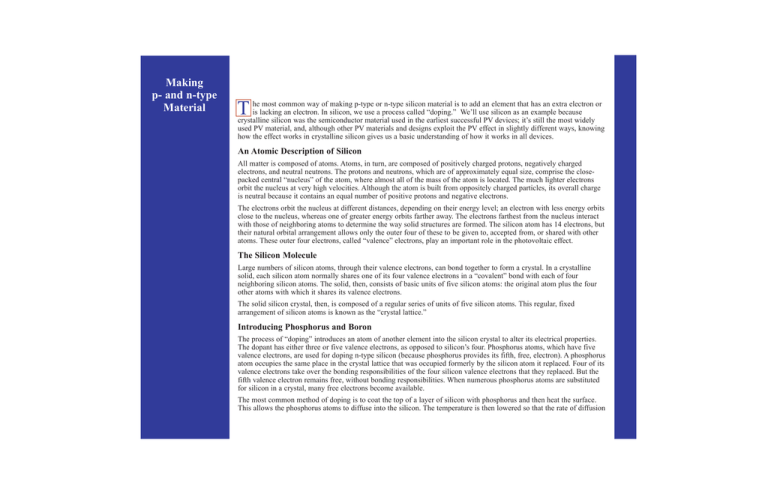Making p- and n
advertisement

Making p- and n-type Material T he most common way of making p-type or n-type silicon material is to add an element that has an extra electron or is lacking an electron. In silicon, we use a process called “doping.” We’ll use silicon as an example because crystalline silicon was the semiconductor material used in the earliest successful PV devices; it’s still the most widely used PV material, and, although other PV materials and designs exploit the PV effect in slightly different ways, knowing how the effect works in crystalline silicon gives us a basic understanding of how it works in all devices. An Atomic Description of Silicon All matter is composed of atoms. Atoms, in turn, are composed of positively charged protons, negatively charged electrons, and neutral neutrons. The protons and neutrons, which are of approximately equal size, comprise the closepacked central “nucleus” of the atom, where almost all of the mass of the atom is located. The much lighter electrons orbit the nucleus at very high velocities. Although the atom is built from oppositely charged particles, its overall charge is neutral because it contains an equal number of positive protons and negative electrons. The electrons orbit the nucleus at different distances, depending on their energy level; an electron with less energy orbits close to the nucleus, whereas one of greater energy orbits farther away. The electrons farthest from the nucleus interact with those of neighboring atoms to determine the way solid structures are formed. The silicon atom has 14 electrons, but their natural orbital arrangement allows only the outer four of these to be given to, accepted from, or shared with other atoms. These outer four electrons, called “valence” electrons, play an important role in the photovoltaic effect. The Silicon Molecule Large numbers of silicon atoms, through their valence electrons, can bond together to form a crystal. In a crystalline solid, each silicon atom normally shares one of its four valence electrons in a “covalent” bond with each of four neighboring silicon atoms. The solid, then, consists of basic units of five silicon atoms: the original atom plus the four other atoms with which it shares its valence electrons. The solid silicon crystal, then, is composed of a regular series of units of five silicon atoms. This regular, fixed arrangement of silicon atoms is known as the “crystal lattice.” Introducing Phosphorus and Boron The process of “doping” introduces an atom of another element into the silicon crystal to alter its electrical properties. The dopant has either three or five valence electrons, as opposed to silicon’s four. Phosphorus atoms, which have five valence electrons, are used for doping n-type silicon (because phosphorus provides its fifth, free, electron). A phosphorus atom occupies the same place in the crystal lattice that was occupied formerly by the silicon atom it replaced. Four of its valence electrons take over the bonding responsibilities of the four silicon valence electrons that they replaced. But the fifth valence electron remains free, without bonding responsibilities. When numerous phosphorus atoms are substituted for silicon in a crystal, many free electrons become available. The most common method of doping is to coat the top of a layer of silicon with phosphorus and then heat the surface. This allows the phosphorus atoms to diffuse into the silicon. The temperature is then lowered so that the rate of diffusion drops to zero. Other methods of introducing phosphorus into silicon include gaseous diffusion, a liquid dopant spray-on process, and a technique in which phosphorus ions are driven precisely into the surface of the silicon. Of course, n-type silicon cannot form the electric field by itself; it’s also necessary to have some silicon altered to have the opposite electrical properties. So, boron, which has three valence electrons, is used for doping p-type silicon. Boron is introduced during silicon processing, where silicon is purified for use in PV devices. When a boron atom assumes a position in the crystal lattice formerly occupied by a silicon atom, there is a bond missing an electron (in other words, an extra hole). Other Semiconductor Materials Like silicon, all PV materials must be made into p-type and n-type configurations to create the necessary electric field that characterizes a PV cell. This is done a number of different ways, depending on the characteristics of the material; for example, amorphous silicon’s unique structure makes an intrinsic layer (or i layer) necessary. This undoped layer of amorphous silicon fits between the n-type and p-type layers to form what is called a “p-i-n” design. Polycrystalline thin films like copper indium diselenide (CuInSe2) and cadmium telluride (CdTe) show great promise for PV cells. But these materials can’t be simply doped to form n- and p-layers. Instead, layers of different materials are used to form these layers; for example, a “window” layer of cadmium sulfide or similar material is used to provide the extra electrons necessary to make it n-type. CuInSe2 can itself be made p-type, whereas CdTe benefits from a p-type layer made from a material like zinc telluride (ZnTe). Gallium arsenide (GaAs) is similarly modified, usually with indium, phosphorus, or aluminum, to produce a wide range of n- and p-type materials. Return Home ➤

